CFD Evaluation on the Pre- and Post- Renovation, and Windows and Doors Opening, of a Typical, Walled, Detached Family House in the Philippines
Abstract
:1. Introduction
2. Methodology
2.1. Computational Fluid Dynamics
2.2. Numerical Modelling
2.3. Simulation Cases
3. Results and Discussion
3.1. Effect of House Perimeter Wall
3.2. Effect of Constructed Firewall, Window, and Door Openings
3.3. Effect of Left Wall Opening
3.4. General Results
4. Conclusions
- The lot perimeter wall affects the wind field surrounding the house. The lot perimeter wall results in a decrease of fresh air coming inside the house and its surroundings. This will result in a reduction of natural ventilation and fresh air, and will increase discomfort and lower indoor air quality. Hence, this also results in the application of mechanical means such as air fans and air-conditioning systems that result in the increase of energy consumption of the house.
- Opening the doors and windows is significant in the cross flow ventilation in the house, as shown in the different cases. As presented, it is very important to open the bedroom doors to increase the wind passing through the room for natural ventilation, particularly in the case of the rooms with windows on one side only.
- To avoid air recirculation and stagnation, particularly in the detached house with a very high lot perimeter wall, it is important to consider opening some portion of the wall to increase the wind passing through the house to minimize air stagnation and recirculation that might result in poor ventilation and air quality. The opening at the left of the lot perimeter wall, as presented in the study, shows the increase in wind passing through the house.
Acknowledgment
Author Contributions
Conflicts of Interest
References
- Enteria, N.; Cuartero, O. A Review of the Recent Development of the Philippine Household Technologies and Energy Consumption. Recent Patents Eng. 2017, 11, 35–48. [Google Scholar] [CrossRef]
- Enteria, N.; Awbi, H.; Yoshino, H. Application of Renewable Energy Sources and New Building Technologies for the Philippine Single Family Detached House. Int. J. Energy Environ. Eng. 2015, 6, 267–294. [Google Scholar] [CrossRef]
- Li, J.Q.; Ward, I.C. Investigation of Roof Pitch and Wind Induced Ventilation by Computational Fluid Dynamics. In Proceedings of the 23rd Conference on Passive and Low Energy Architecture, Geneva, Switzerland, 6–8 September 2006. [Google Scholar]
- Tam, N.V.; Trigaux, D.; Allacker, K.; Troyer, F.D. Optimization for Passive Design of Large Scale Housing Projects for Energy and Thermal Comfort in a Hot and Humid Climate. In Proceedings of the 30th International PLEA Conference, Ahmedabad, India, 16–18 December 2014. [Google Scholar]
- Ayata, T. Investigation of Building Height and Roof Effect on the Air Velocity and Pressure Distribution Around the Detached Houses in Turkey. Appl. Therm. Eng. 2017, 29, 1752–1758. [Google Scholar] [CrossRef]
- Wang, L.; Wong, N.H. Applying Natural Ventilation for Thermal Comfort in Residential Buildings in Singapore. Archit. Sci. Rev. 2007, 50, 224–233. [Google Scholar]
- Nugroho, A.M.; Ahmad, M.H.; Ossen, D.R. A Preliminary Study of Thermal Comfort in Malaysia’s Single Storey Terraced Houses. J. Asian Archit. Build. Eng. 2007, 6, 175–182. [Google Scholar] [CrossRef]
- Li, Y.; Heiselberg, P. Analysis methods for natural and hybrid ventilation—A critical literature review and recent developments. Int. J. Vent. 2003, 4, 3–20. [Google Scholar] [CrossRef]
- Mora-Pérez, M.; Guillén Guillamón, I.E.; López Jiménez, P.A.; López-Patiño, G. Natural Ventilation Building Design Approach in Mediterranean Regions: A Case Study at the Valencian Coastal Regional Scale (Spain). Sustainability 2016, 8, 855. [Google Scholar] [CrossRef]
- Linden, P.F. The fluid mechanics of natural ventilation. Annu. Rev. Fluid Mech. 2009, 31, 201–208. [Google Scholar] [CrossRef]
- BCA Green Mark. Appendix C: Ventilation Simulation Methodology and Requirement. In Certification Standard for New Buildings; Building and Construction Authority: Singapore, 2010. [Google Scholar]
- Baharum, M.A.; Surat, M.; Tawil, N.M.; Che-Ani, A.I. Modern Housing Tranquility in Malaysia from the Aspect of Thermal Comfort for Humid Hot Climate Zone. In E3S Web of Conferences; Emerging Technology for Sustainable Development Congress: Bangi, Malaysia, 2014. [Google Scholar]
- Mousli, K.; Semprini, G. An Investigation of Natural Ventilation in a Courtyard House to Achieve Thermal Comfort in Hot-Arid Climate. In Proceedings of the 9th International Conference on Indoor Air Quality Ventilation & Energy Conservation in Buildings, Songdo, Korea, 23–26 October 2016. [Google Scholar]
- Chu, Y.C.; Hsu, M.F.; Hsieh, C.M. A Field Assessment on Natural Ventilation and Thermal Comfort of Historical District—A Case of the Wugoushui Settlement in Taiwan. In Proceedings of the ICUC9—9th International Conference on Urban Climate jointly with 12th Symposium on the Urban Environment, Toulouse, France, 20–24 July 2015. [Google Scholar]
- Tablada, A.; Troyer, F.D.; Blocken, B.; Carmeliet, B.J.; Verschure, H. On Natural Ventilation and Thermal Comfort in Compact Urban Environments—The Old Havana Case. Build. Environ. 2009, 44, 1943–1958. [Google Scholar] [CrossRef]
- Cheng, V.; Ng, E. Wind for Comfort in High Density Cities. In Proceedings of the 25th Conference on Passive and Low Energy Architecture (PLEA 2008), Dublin, Ireland, 22–24 October 2008. [Google Scholar]
- Enteria, N. CFD Evaluation of Philippine Detached Structure with Different Roofing Designs. Infrastructures 2006, 1, 3. [Google Scholar] [CrossRef]
- Enteria, N.; Yoshino, H.; Mochida, A.; Takaki, R.; Yoshie, R.; Mitamura, T.; Baba, S. Synergization of Clean Energy Utilization, Clean Technology Development and Controlled Clean Environment Through Thermally Activated Desiccant Cooling System. In Proceedings of the 2008 ASME International Conference on Energy Sustainability, Jacksonville, FL, USA, 10–14 August 2008. [Google Scholar]
- OpenFOAM. Available online: http://www.openfoam.com/ (accessed on 14 December 2016).
- simFlow. Available online: https://sim-flow.com/ (accessed on 8 September 2016).
- Dose, B.; Medjroubi, W.; Stoevesandt, B. CFD Simulations of 2.5 MW Turbine using ANSYS CFX and Openfoam. In Proceedings of the First Symposium on OpenFOAM in Wind Energy, Oldenburg, Germany, 21 March 2013; Available online: http://www.forwind.de/sowe/Site/Program_files/SOWE2013_Dose.pdf (accessed on 23 January 2017).
- Casella, L.; Langreder, W.; Fisher, A.; Ehlen, M.; Skoutelakos, D. Dynamic Flow Analysis using an Openfoam based CFD Tool: Validation of Turbulence Intensity in a Testing Site. In Proceedings of the First Symposium on OpenFOAM® in Wind Energy, Oldenburg, Germany, 20–21 March 2013. [Google Scholar]
- Kerklaan, R.A.G. Design Tools for the Virtual Wind Tunnel Setting Up the Geometry for CFD Calculations. Master’s Thesis, Delft University of Technology, Delft, The Netherlands, 2006. [Google Scholar]
- Tamura, T.; Nozawa, K.; Kondo, K. AIJ Guide for Numerical Prediction of Wind Loads on Buildings. J. Wind Eng. Ind. Aerodyn. 2008, 96, 1974–1984. [Google Scholar] [CrossRef]
- Tominaga, Y.; Mochida, A.; Yoshie, R.; Kataoka, H.; Nozu, T.; Yoshikawa, M.; Shirasawa, T. AIJ Guidelines for Practical Applications of CFD to Pedestrian Wind Environment Around Buildings. J. Wind Eng. Ind. Aerodyn. 2008, 96, 1749–1761. [Google Scholar] [CrossRef]
- Franke, J.; Hellsten, A.; Schlunzen, H.; Carrissimo, B. (Eds.) Best Practice Guideline for the CFD Simulation of Flows in the Urban Environment; COST Office: Brussels, Belgium, 2007. [Google Scholar]
- Weather Spark. Average Weather in Davao Philippine. Available online: https://weatherspark.com/averages/33314/Davao-City-Davao-Region-Philippines (accessed on 26 July 2016).
- Irtaza, H.; Beale, R.G.; Godley, M.H.R.; Jameel, A. Comparison of Wind Pressure Measurement on Silsoe Experimental Building from Full-Scale Observation, Wind-Tunnel Experiments and Various CFD Techniques. Int. J. Eng. Sci. Technol. 2013, 5, 28–41. [Google Scholar] [CrossRef]
- Abohela, I.; Hamza, N.; Dehek, S. Effect of Roof Shape on Energy Yield and Positioning of Roof Mounted Turbines. In Proceedings of the 12th Conference of International Building Performance Simulation Association, Sydney, Australia, 14–16 November 2011. [Google Scholar]
- Blocken, B.; Stathopoulos, T.; Carmeliet, J. CFD Simulation of the Atmospheric Boundary Layer: Wall Function Problems. Atmos. Environ. 2007, 41, 238–252. [Google Scholar] [CrossRef]
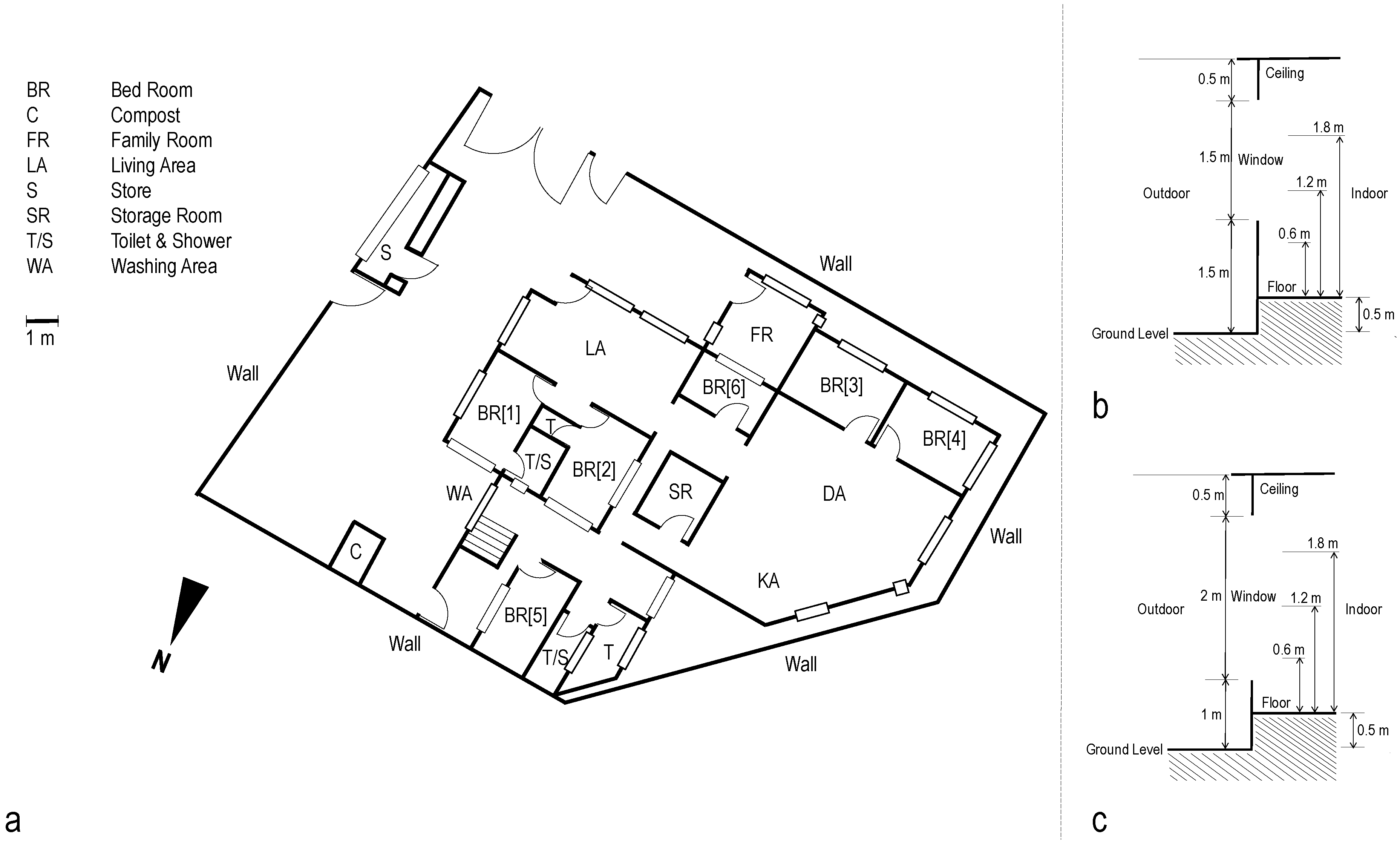
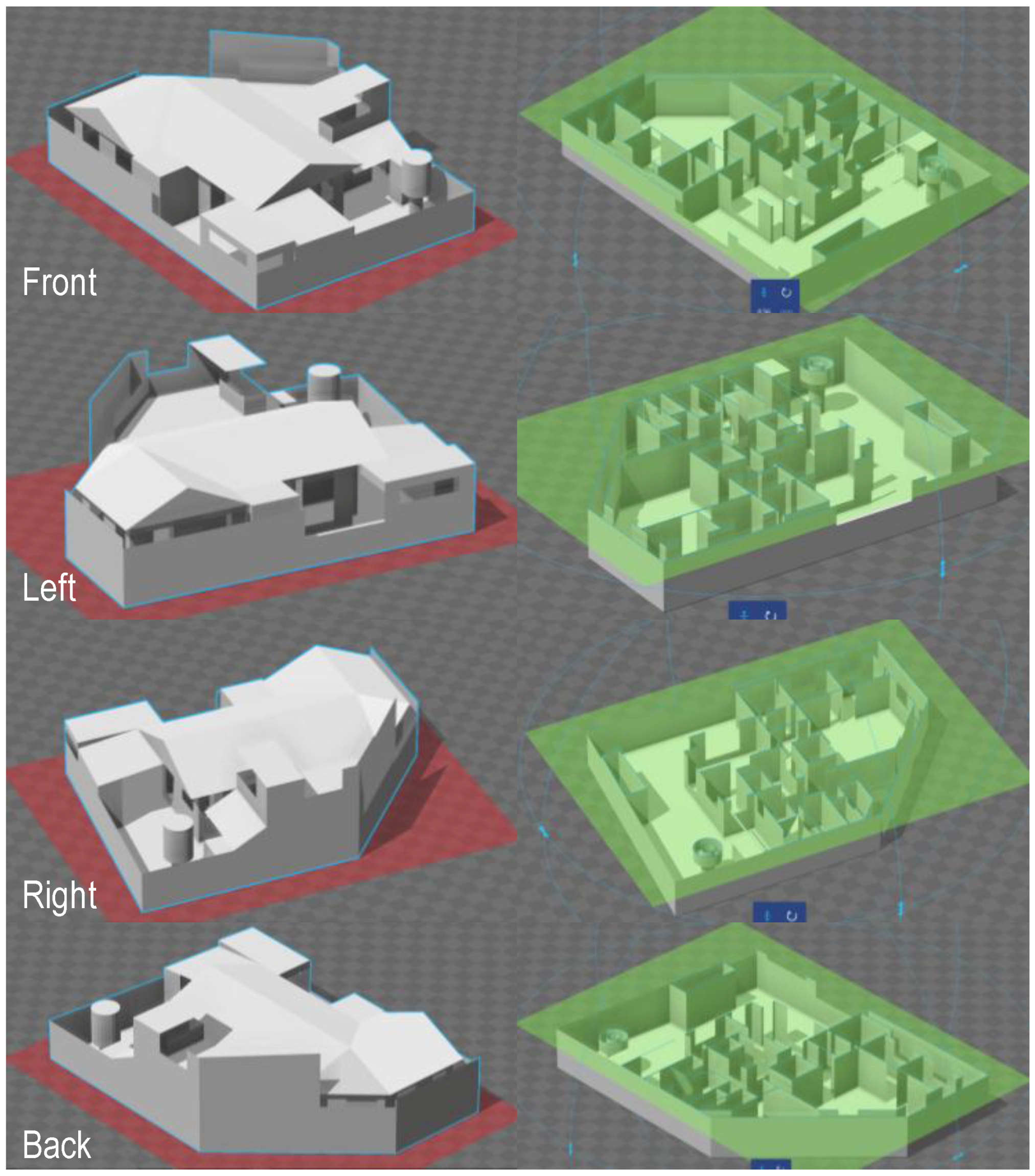
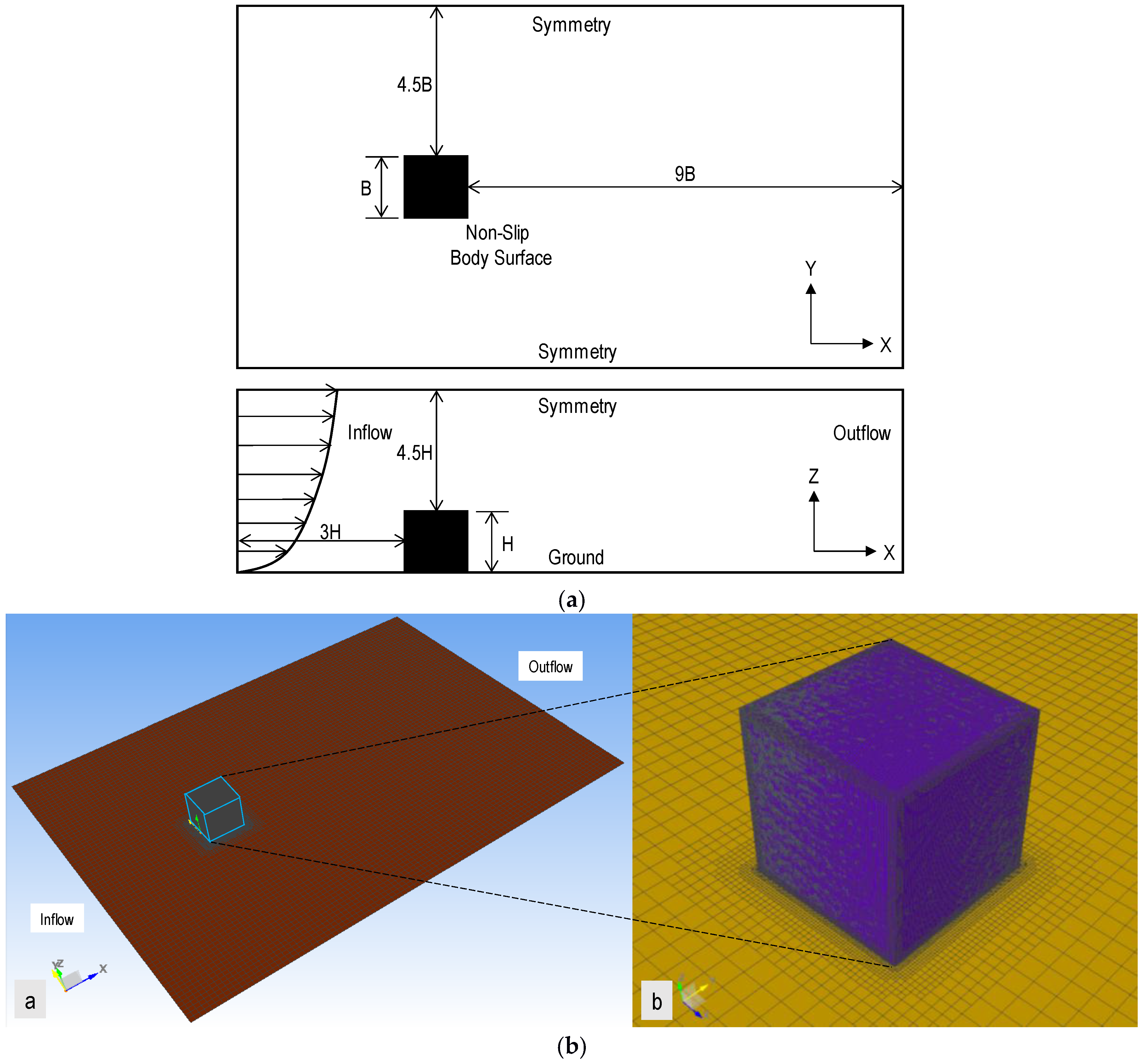
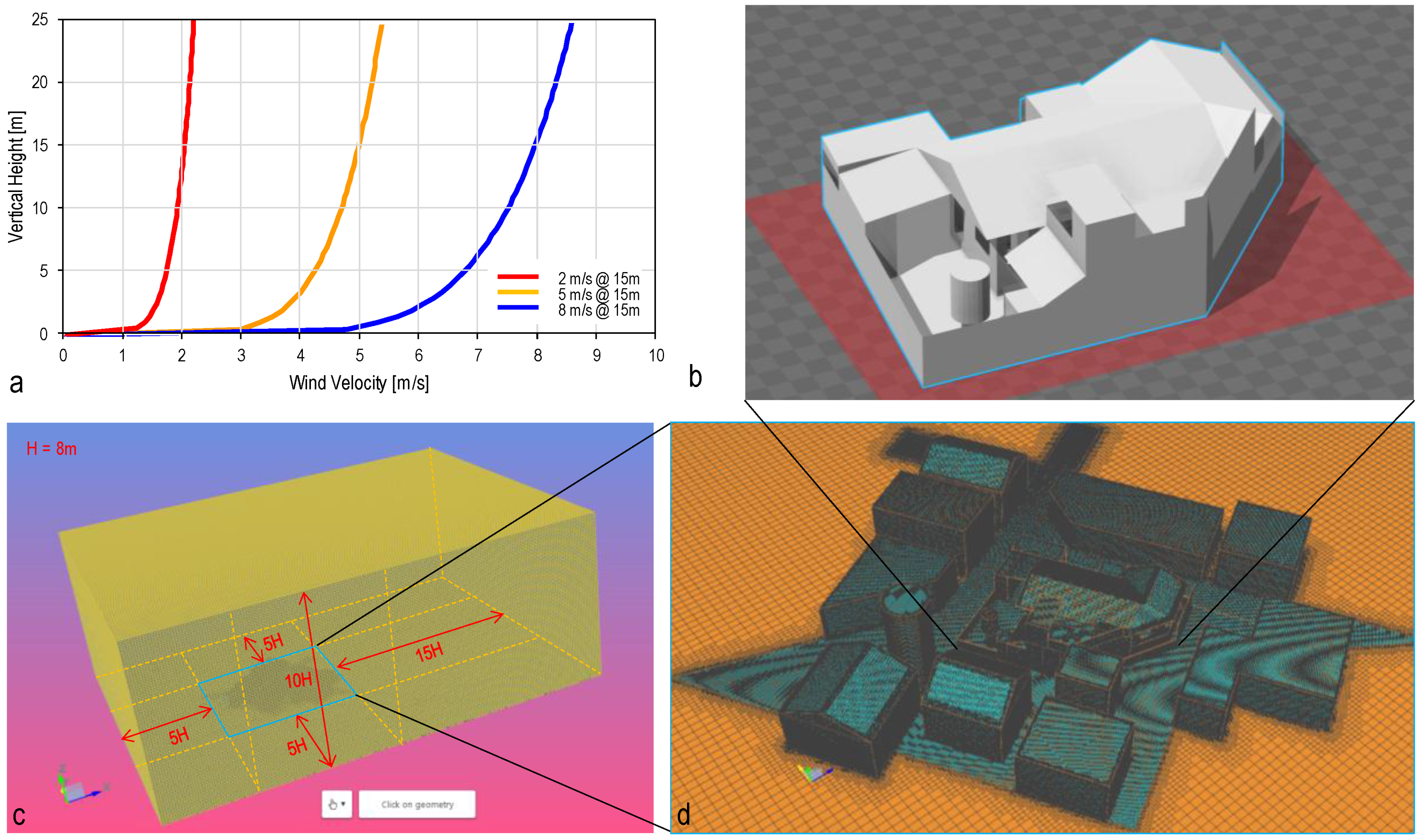
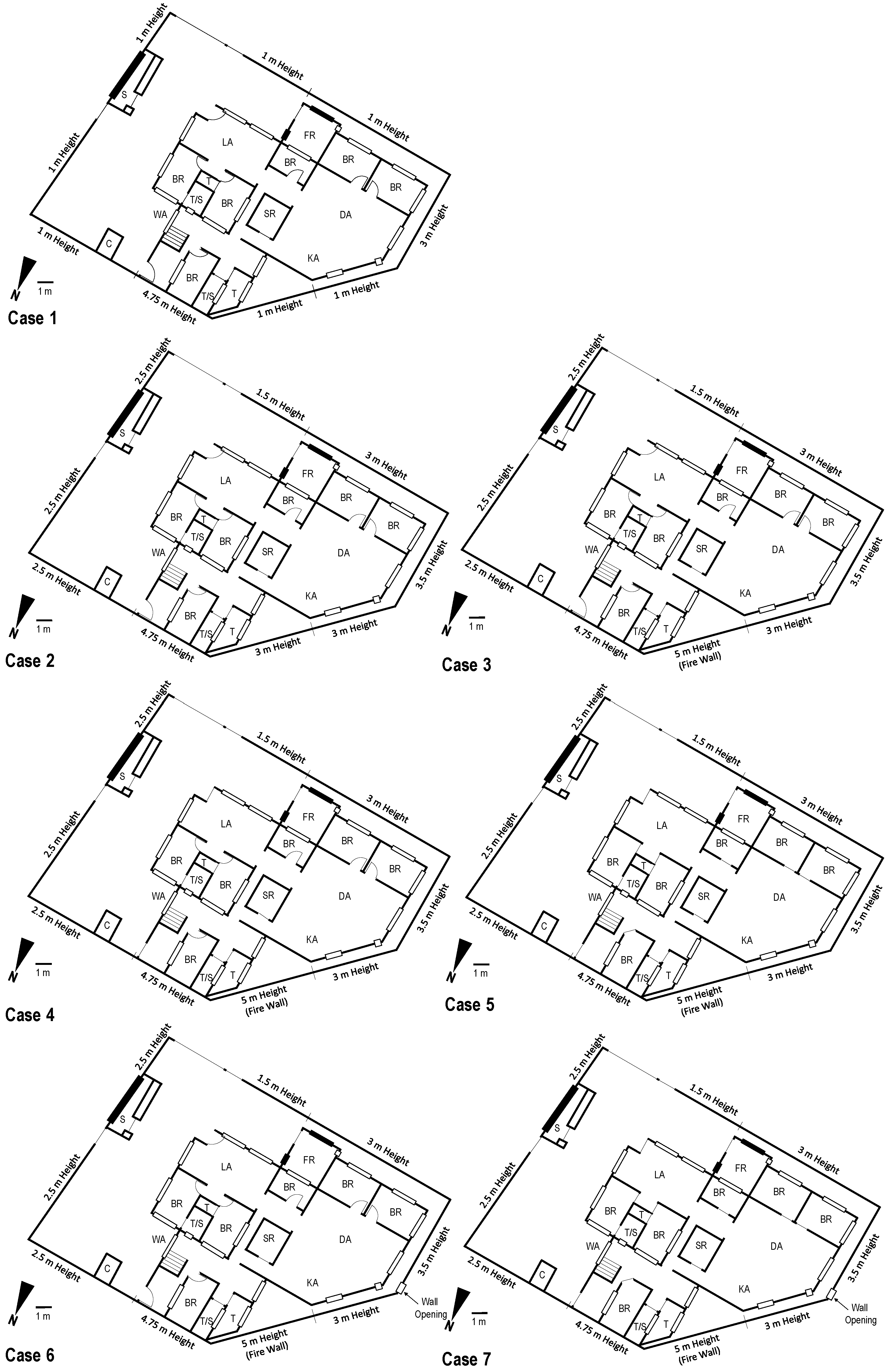
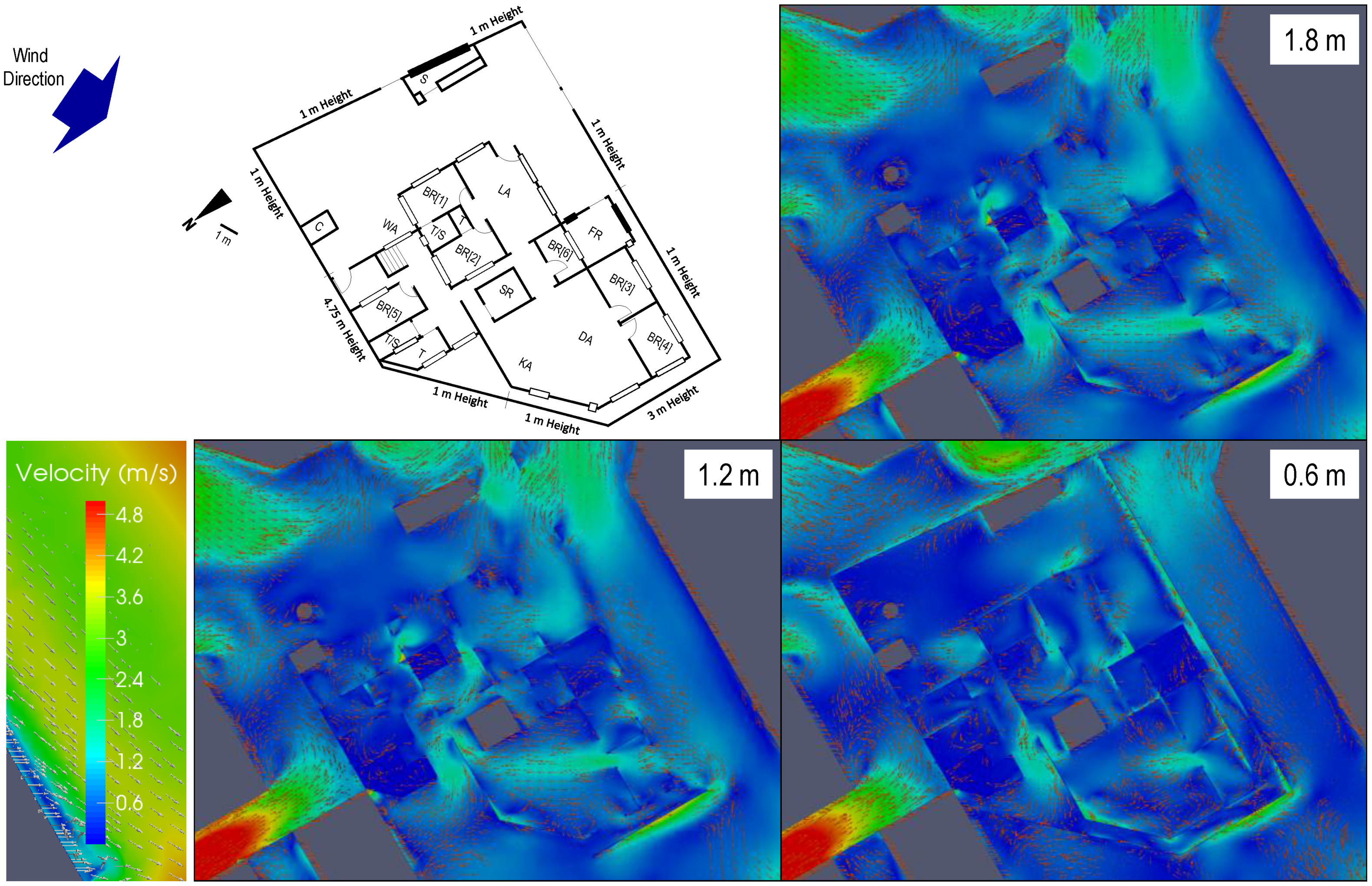
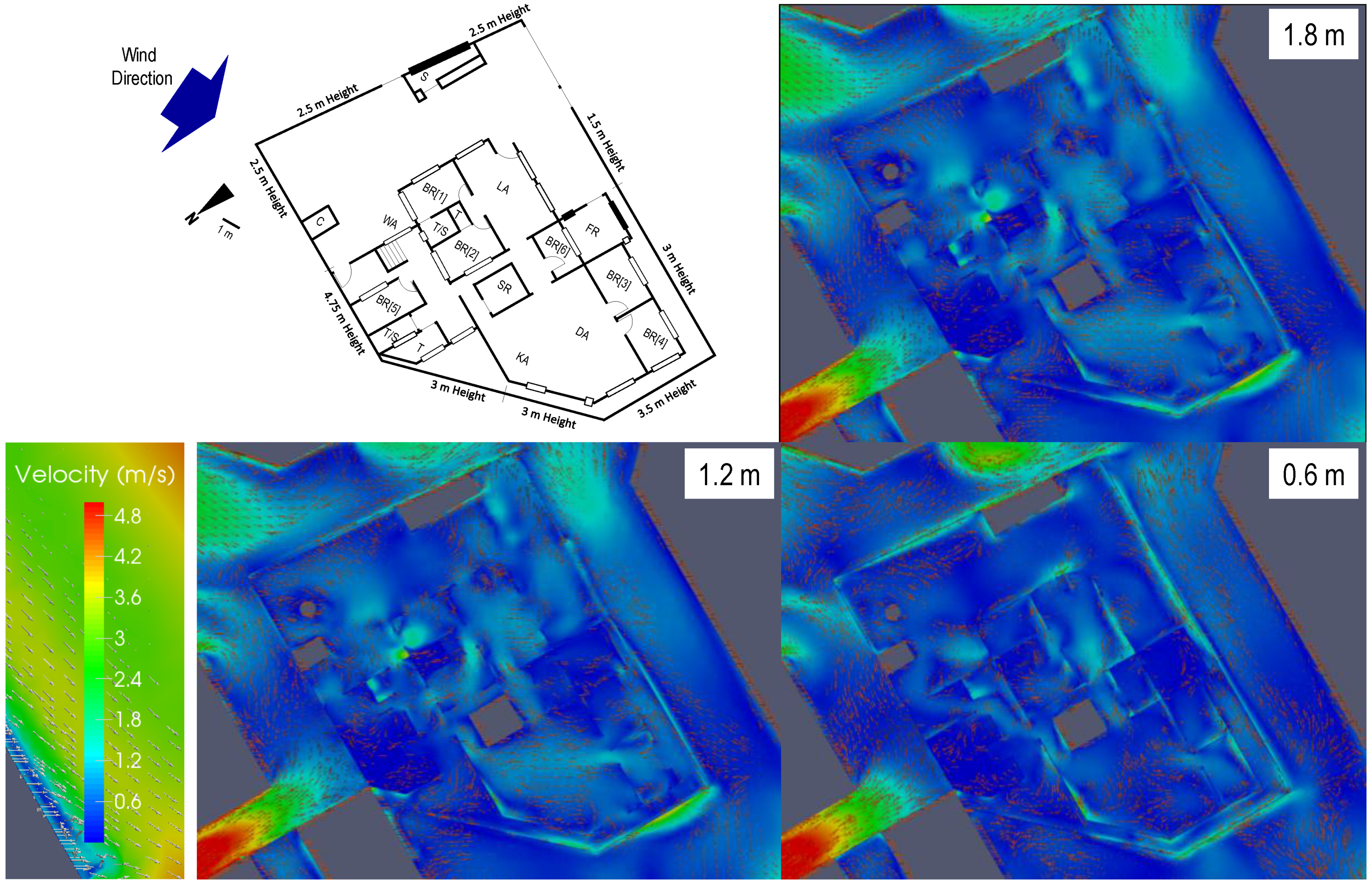
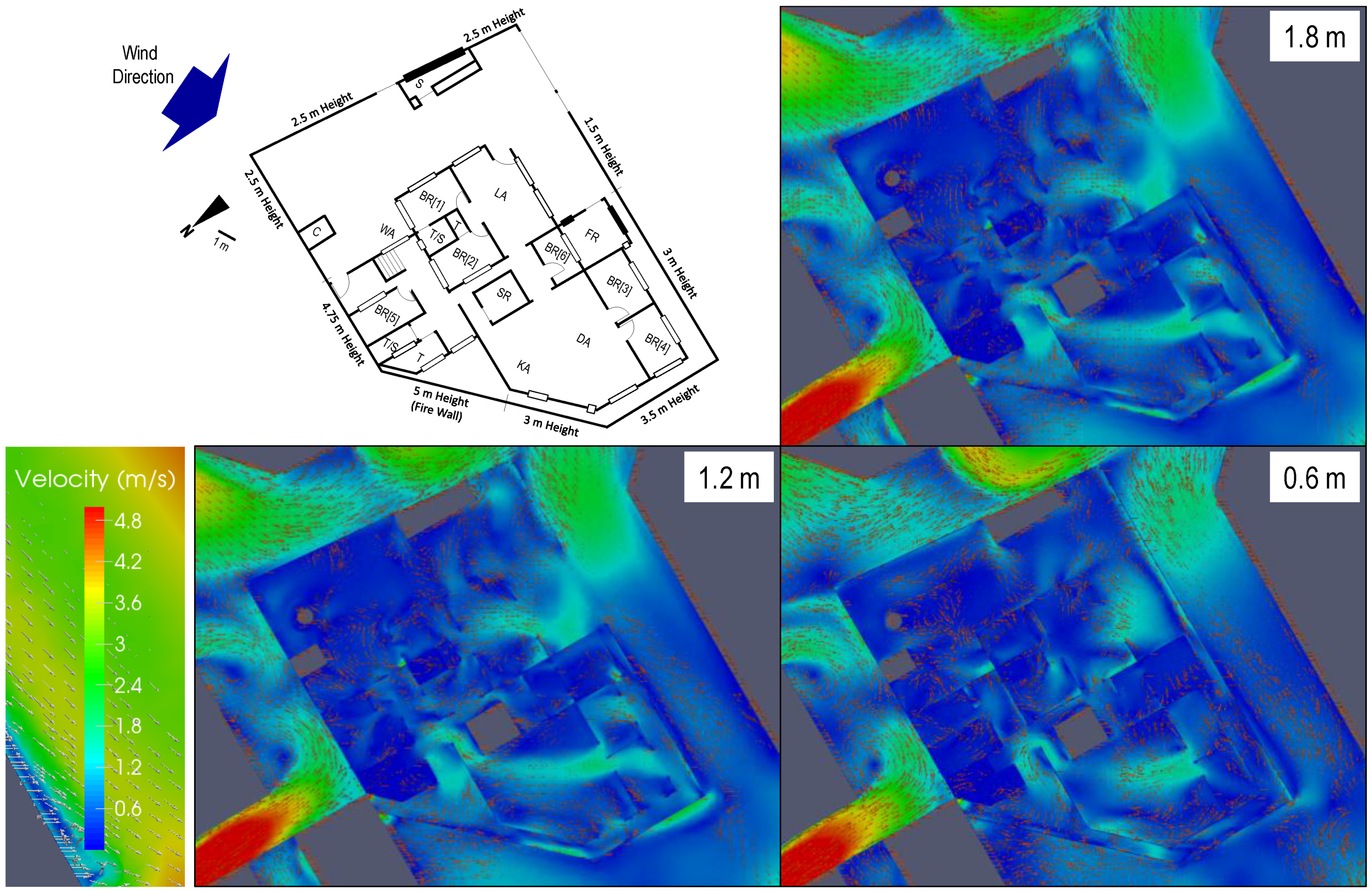
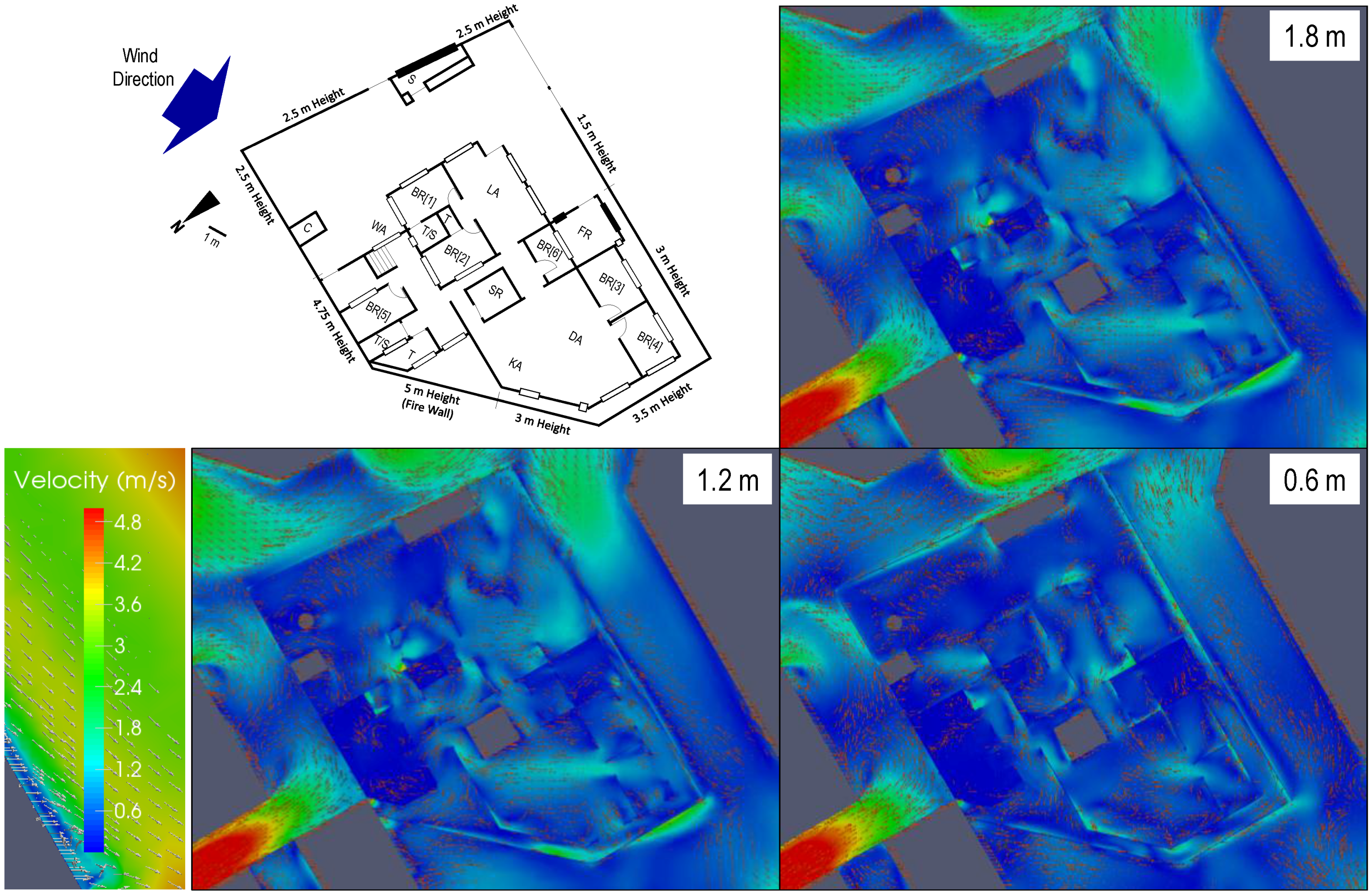
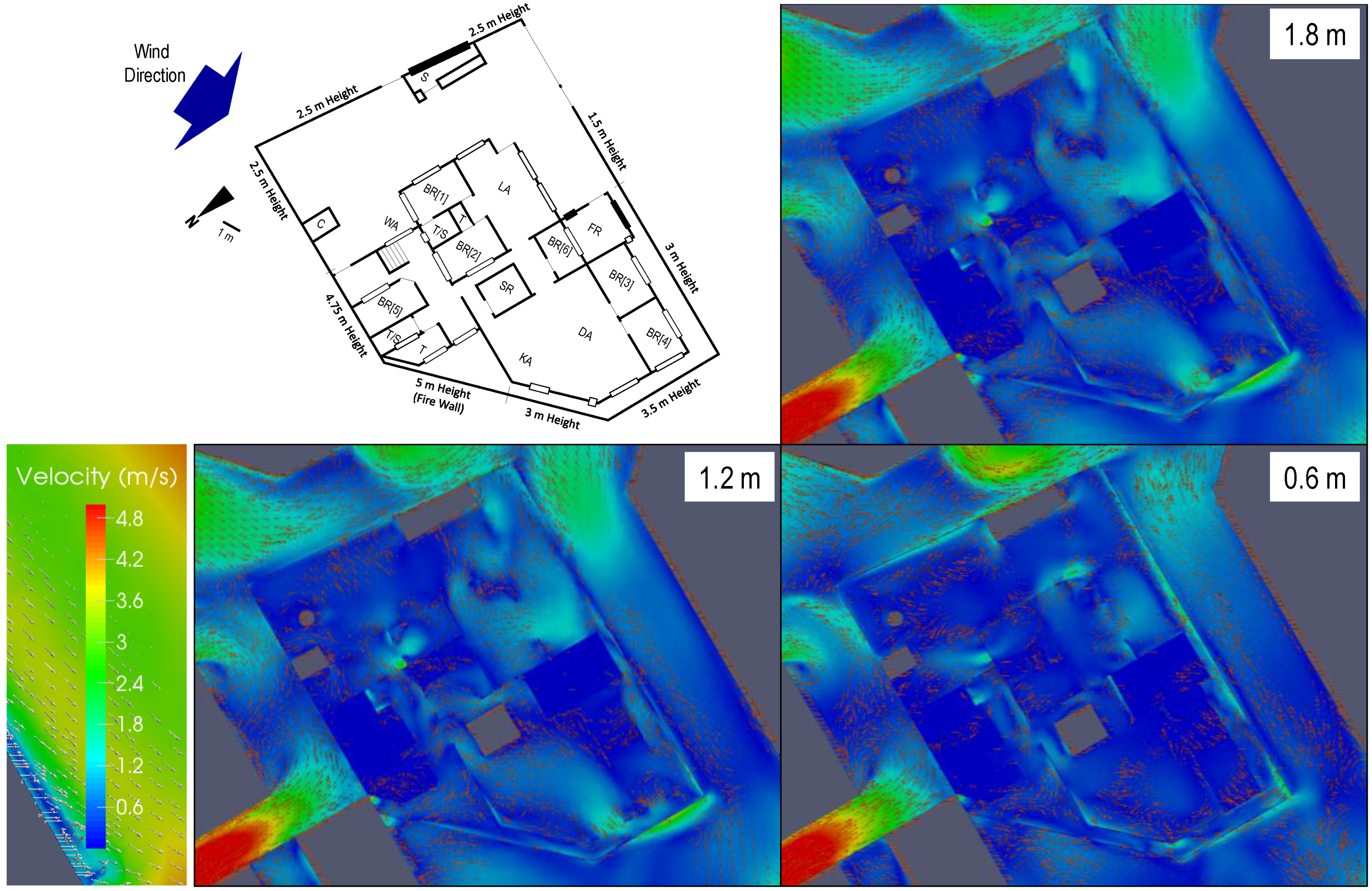
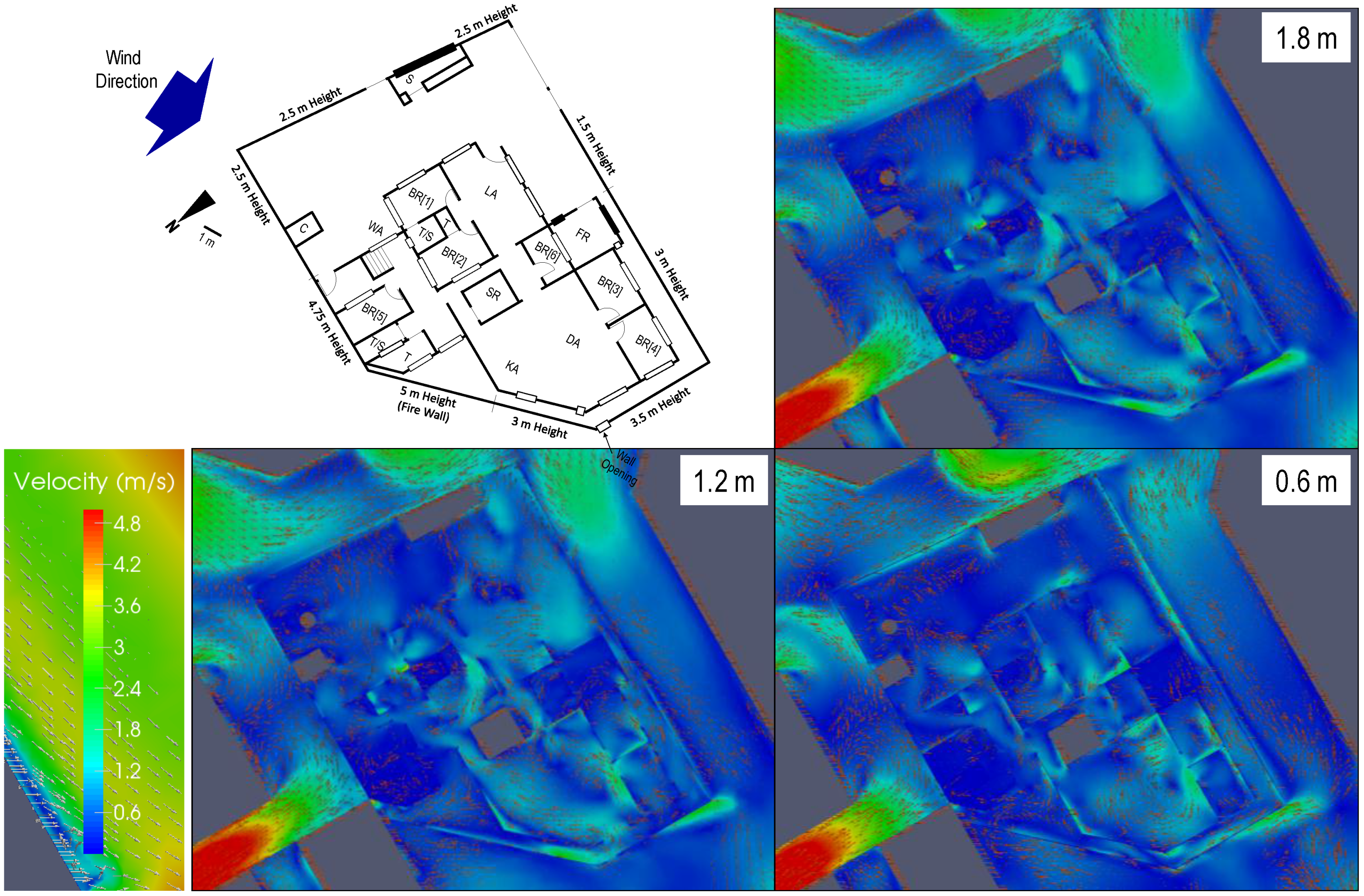
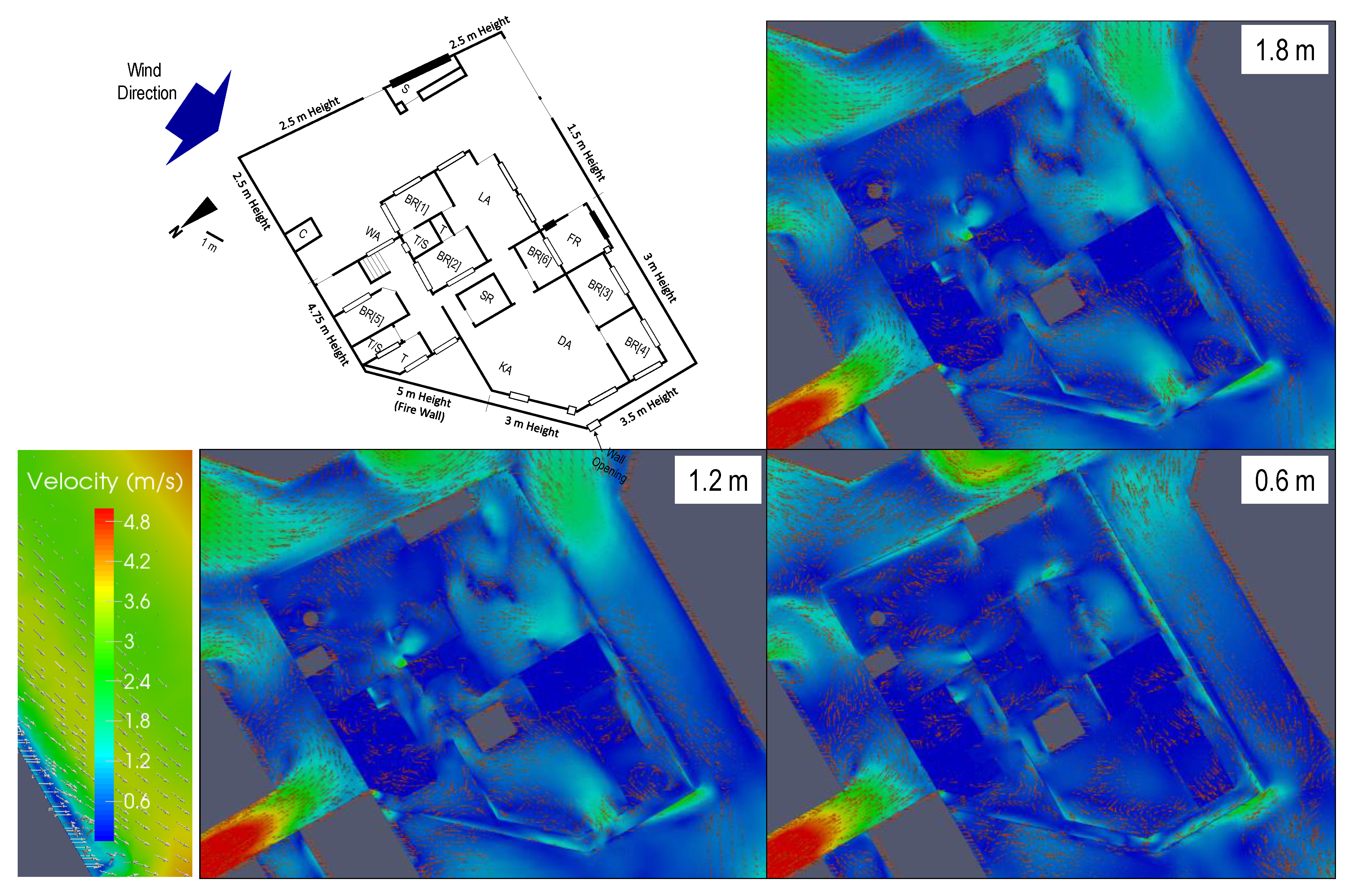
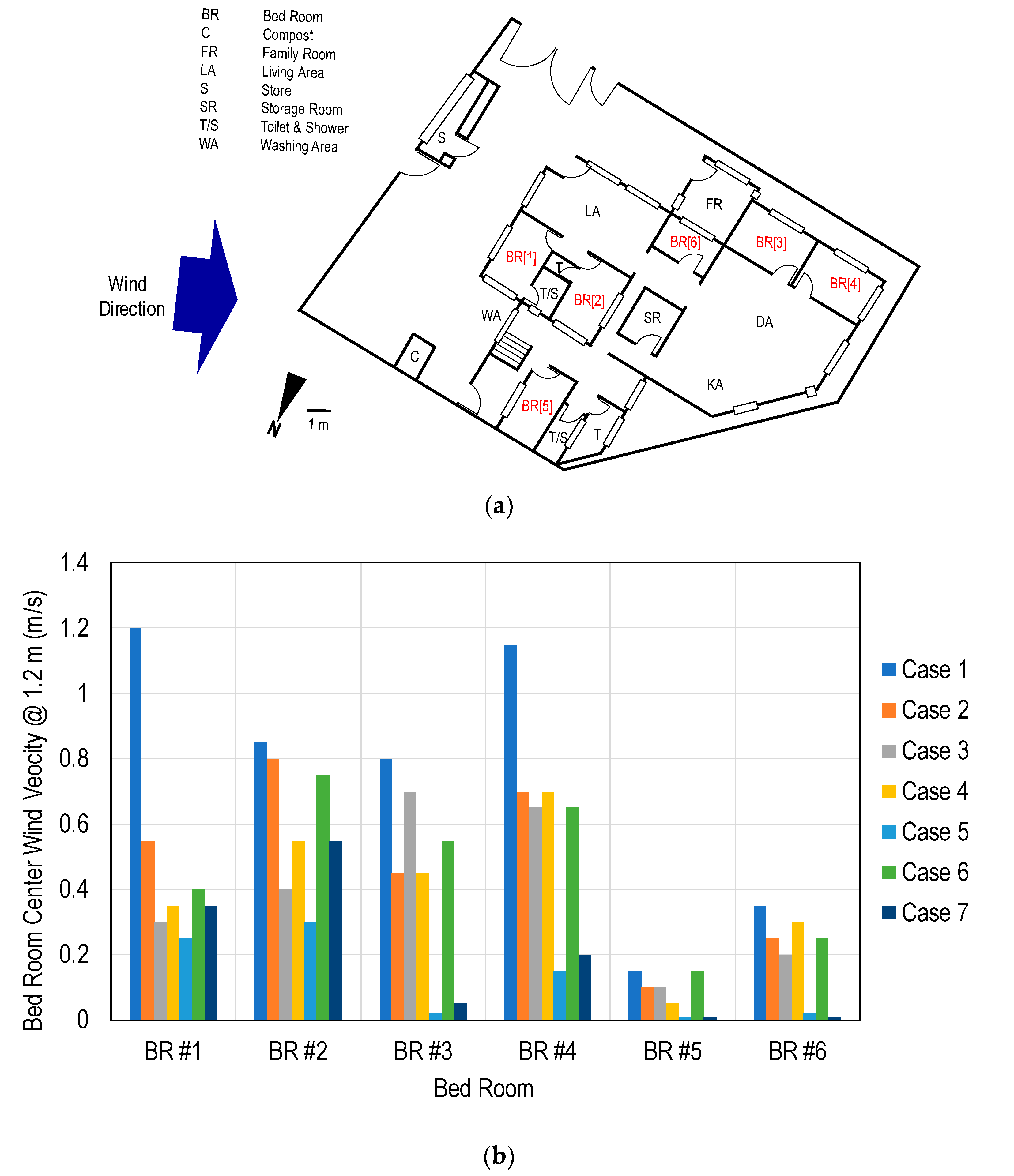
| Front Wall | Left Wall | Fire Wall | Windows | Front Door & Back Door | Bedrooms Door | Left Wall Opening | |
| Case 1 | 1.0 m & 1.0 m | 3.0 m | 1.0 m | Opened | Opened | Opened | No |
| Case 2 | 1.5 m & 3.0 m | 3.5 m | 3.0 m | Opened | Opened | Opened | No |
| Case 3 | 1.5 m & 3.0 m | 3.5 m | 5.0 m | Opened | Opened | Opened | No |
| Case 4 | 1.5 m & 3.0 m | 3.5 m | 5.0 m | Opened | Closed | Opened | No |
| Case 5 | 1.5 m & 3.0 m | 3.5 m | 5.0 m | Opened | Closed | Closed | No |
| Case 6 | 1.5 m & 3.0 m | 3.5 m | 5.0 m | Opened | Opened | Opened | Yes |
| Case 7 | 1.5 m & 3.0 m | 3.5 m | 5.0 m | Opened | Closed | Closed | Yes |
© 2017 by the authors. Licensee MDPI, Basel, Switzerland. This article is an open access article distributed under the terms and conditions of the Creative Commons Attribution (CC BY) license (http://creativecommons.org/licenses/by/4.0/).
Share and Cite
Enteria, N.A.; Cuartero-Enteria, O.L. CFD Evaluation on the Pre- and Post- Renovation, and Windows and Doors Opening, of a Typical, Walled, Detached Family House in the Philippines. Infrastructures 2017, 2, 16. https://doi.org/10.3390/infrastructures2040016
Enteria NA, Cuartero-Enteria OL. CFD Evaluation on the Pre- and Post- Renovation, and Windows and Doors Opening, of a Typical, Walled, Detached Family House in the Philippines. Infrastructures. 2017; 2(4):16. https://doi.org/10.3390/infrastructures2040016
Chicago/Turabian StyleEnteria, Napoleon A., and Odinah L. Cuartero-Enteria. 2017. "CFD Evaluation on the Pre- and Post- Renovation, and Windows and Doors Opening, of a Typical, Walled, Detached Family House in the Philippines" Infrastructures 2, no. 4: 16. https://doi.org/10.3390/infrastructures2040016





